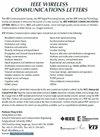OFDM-Based NOMA-Enhanced Coexistence of SemCom and BitCom System
IF 5.5
3区 计算机科学
Q1 COMPUTER SCIENCE, INFORMATION SYSTEMS
引用次数: 0
Abstract
To facilitate the popularization and application of semantic communication, it is crucial to ensure its efficient coexistence with traditional digital communication networks. In this letter, we investigate a non-orthogonal multiple access (NOMA)-enabled heterogeneous semantic communication (SemCom) and bit communication (BitCom) coexistence system under an orthogonal frequency division multiplexing (OFDM) framework. The deployment of fluid antennas at the user side is treated as a crucial strategy to enhance system efficiency and mitigate interference. Within the above OFDM framework, we construct a frequency domain channel with multicarriers, based on the multipath channel characteristics exhibited by different fluid antenna ports. Subsequently, a sum semantic rate maximization problem is formulated by optimizing the subcarrier allocation, power allocation, and the fluid antenna port selection of the users. Note that the derived problem is challenging to solve through conventional methods due to the presence of highly coupled continuous and discrete variables. To address this challenge, we propose a dual proximal policy optimization (DPPO) algorithm as a solution for this problem, which divides the problem into two parts and leverages separate subnetworks to solve each part. Simulation results demonstrate the efficiency of the proposed algorithms in enhancing the sum semantic rate.基于ofdm的noma增强SemCom和BitCom系统共存
为了促进语义通信的普及和应用,确保语义通信与传统数字通信网络的有效共存是至关重要的。在这封信中,我们研究了在正交频分复用(OFDM)框架下非正交多址(NOMA)支持的异构语义通信(SemCom)和位通信(BitCom)共存系统。在用户端部署流体天线被视为提高系统效率和减少干扰的关键策略。在上述OFDM框架内,我们基于不同流体天线端口所表现出的多径信道特性,构建了一个多载波频域信道。然后,通过优化用户的子载波分配、功率分配和流体天线端口选择,形成和语义速率最大化问题。请注意,由于存在高度耦合的连续变量和离散变量,推导问题很难通过传统方法解决。为了解决这一挑战,我们提出了一种双近端策略优化(DPPO)算法作为该问题的解决方案,该算法将问题分为两个部分,并利用单独的子网来解决每个部分。仿真结果证明了所提算法在提高和语义率方面的有效性。
本文章由计算机程序翻译,如有差异,请以英文原文为准。
求助全文
约1分钟内获得全文
求助全文
来源期刊

IEEE Wireless Communications Letters
Engineering-Electrical and Electronic Engineering
CiteScore
12.30
自引率
6.30%
发文量
481
期刊介绍:
IEEE Wireless Communications Letters publishes short papers in a rapid publication cycle on advances in the state-of-the-art of wireless communications. Both theoretical contributions (including new techniques, concepts, and analyses) and practical contributions (including system experiments and prototypes, and new applications) are encouraged. This journal focuses on the physical layer and the link layer of wireless communication systems.
 求助内容:
求助内容: 应助结果提醒方式:
应助结果提醒方式:


